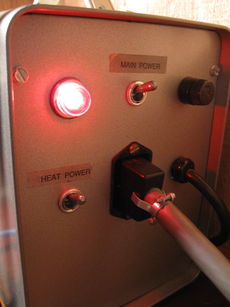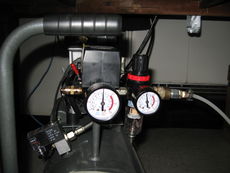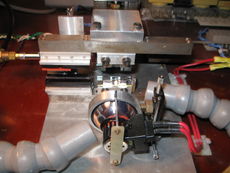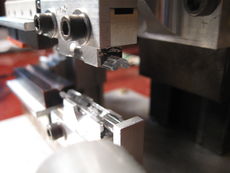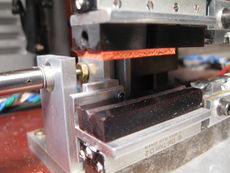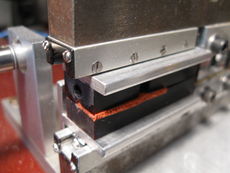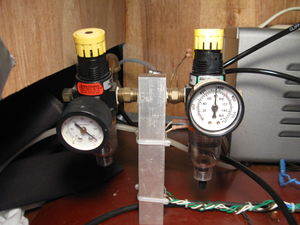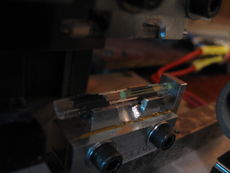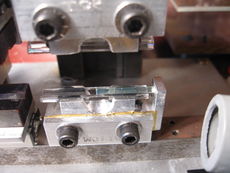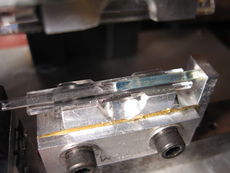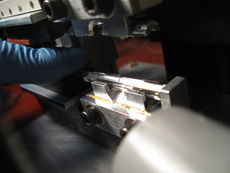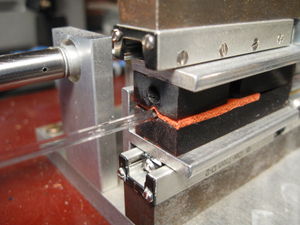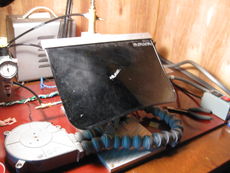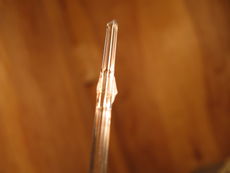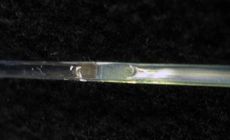BW New Procedure
Overview
The joint between the SciFI and the light guide is one of the most critical points in the construction of the tagger microscope. Prior attempts to glue this joint with epoxy proved to be mechanically unreliable. A splicing unit has been procured from MSU and retrofitted for use with square fibers. Special order glass ferrules are used to maintain the fibers' shape while the union between the SciFi and light guide are heated to melting point.
Safety Information: During the fusing process, it is important to wear powder-free gloves and long sleeves (or a lab coat). Do not look at the light or near the fusing site while the lamp is turned on as it is extremely bright. Do not touch the fusing lamp ever, as it gets very hot and oil from skin will cause the lamp to break.
Procedure
- Power up the fusing unit by turning the two power switches on. The compressor should always be plugged in and turned on, with the red power switch down in a horizontal position. The pressure gauge for the compressor tank should read between 100 and 120 PSI.
- Make sure the compressor cord is not too taut because if it is it can start pulling the plug out of the electrical outlet.
- Connect the hose that feeds the splicer to the compressor using the quick connect coupler.
- Inspect the splicing unit: Check that the top sliding collar and compression block move smoothly and unencumbered. Check for cracks in the glass ferrules and ensure they are clean. Verify all peripheral equipment is in working order. Note any discrepancies to the lead technician prior to proceeding with the fusing process.
- The left pressure gauge should be approximately 35 psi, and the right pressure gauge should be approximately 45 psi.
- Before fusing any fibers, test the action of the splicer to make sure the top ferrule comes down smoothly and gently to meet the bottom ferrule and rises in a similar way. To do this, put a small piece of scrap fiber and a piece of sponge gasket on the bottom clamp to keep the top and bottom clamps and ferrules separated during the test. Press the "START" button on the right and watch how the top ferrule comes down toward the bottom one. The scrap fiber and sponge gasket between the clamps will prevent the ferrules from slamming together in case the top one comes down too fast. If the top ferrule slams into the bottom ferrule, cracks will develop in the ferrules, allowing liquid to seep out and create irregularities in the fused fiber. If there are problems with the movement of the top ferrule, the splicer needs to be fixed before you fuse any fibers.
- Once the top ferrule has come down all the way, lower the screen to protect your eyes from the heating light. It should come on and shine, then shut off, and the cooling fan will turn on as the timers and relays dictate. After the light has turned off, you can raise the protective screen. When cooling is done, watch how the top ferrule rises. If there are any problems with this process, do not fuse any fibers until the splicer is fixed.
- Before fusing, measure and record the cross-sections of both the SciFi and the light guide about to be fused. The SciFi's cross-sectional measurements should be taken at the center of the fiber, and the light guides measurements should be taken at the non-polished end. Also measure the SciFi's length using a caliper and record along with the cross-sectional measurements. These measurements should be recorded in the Fusing Statistics Google Doc.
- Take a polished SciFi and clean it with either air from a compressor or a canned air duster. Be careful not to chill the fibers since air can come out cold from the canned air duster, and sometimes a cold liquid or blast of frost can come out too. Pull the canned air trigger gently to release a gentle stream of canned air on the fibers.
- With the splicing collars open, place a clean, straight, cut SciFi in the bottom glass ferrule. If the SciFi has a lip on one end but not the other, fuse the end without the lip. Also ensure that the fiber is butted up against the collar stop on the right-hand side and that the fiber is oriented so that its sides lie flat against the sides of the glass ferrule.
- Place the less-polished end of the light guide (which should be the end without a color code) into the bottom glass ferrule so that its sides lie flat against the sides of the ferrule. Make sure the light guide is far enough into the fusing unit such that the less-polished end of the light guide is touching the end of the SciFi.
- Hold the light guide in place while hitting the "START" button to the right. After the automated fusing process clamps the top ferrule to the bottom ferrule, push the top ferrule down to make sure it is in contact with the bottom ferrule. Give the light guide a push to the right to make sure it is firmly in contact with the Sci-Fi.
- In the few seconds between when the collars clamp together and the light turns on, check the following:
- Ensure that the ferrules have clamped properly and the fibers are positioned in the correct orientation.
- Check again that the pressure gauges are at the appropriate pressures.
- Turn down the protective light shield. If there are any problems with this step, hit the "STOP" button to stop the fusing process.
- With the protective shield down and the lamp on, monitor the pressure gauges and watch the fusing process from behind the protective light shield. A line is visible at the junction of the two fibers and it should slowly disappear as the two fibers fuse. If there is an issue with the fusing process, hit the "STOP" button.
- After the fusing process is complete, the ferrules will become unclamped. Carefully remove the fused fibers and inspect the fuse joint. If the fibers do not appear to be completely fused, if there is a significant dimple in the fuse, or if there are air bubbles in the fuse joint, notify the lead technician.
- There will usually be a slight protrusion in the fiber where the ferrules meet due to flow in the melting plastic, however this is small and can be filed off with minimal damage to the cladding by carefully sanding only on the corners of the fuse site.
- If the fibers appear fused, measure and record both cross-sections of the fuse joint. Complete the fusing process for 30 fibers to complete a bundle.
- When you are done fusing, turn off the fusing unit by turning the two power switches off. Disconnect the hose from the compressor to return the splicing unit to atmospheric pressure.
- The compressor tank should be drained every day after fusing is done. First warn people in the lab that there will be a loud noise from draining the compressor. Then open the bottom valve of the compressor above a container. Air and condensed water residue will escape with a loud hissing sound. Tilt the tank to make sure all the water drains from the tank. Once the pressure in the tank has dropped all the way, close the bottom valve and let the tank refill.

